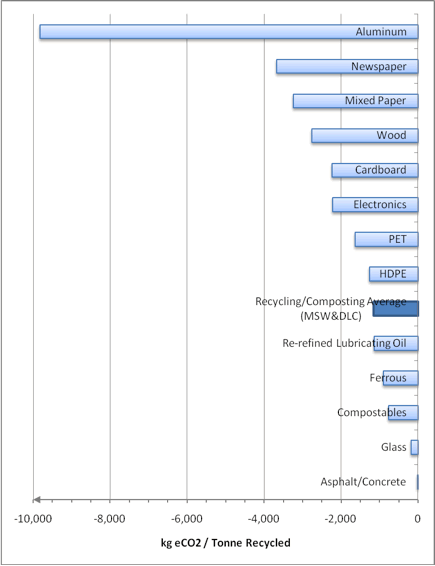MEBCalc™ (Measuring Environmental Benefits Calculator) is Sound Resource Management’s proprietary software for computing the environmental footprint of a community’s municipal solid waste (MSW) management system, from collection through final disposition of each discarded product or packaging material. Environmental impacts covered in the footprint include climate change, public health (respiratory disease, cancer, and toxicity), ecosystem toxicity, waterway nutrification, and acid rain.
MEBCalc™ computes environmental costs and benefits of a community’s choices for waste diversion and disposal methods over the full life cycle of each product and packaging material in the community’s MSW, from resource extraction and refining through production to end-of-life fate. These economic values for the environment can then be compared to the traditional financial costs and benefits of each waste management method for each MSW component.
Specific input data characterizing a community’s MSW management system include:
- Detailed composition quantities for recycled, composted and disposed wastes
- Collection methods and quantities
- Processing methods and quantities
- Disposal methods (e.g., landfills that collect landfill gas and generate electricity, landfills that collect landfill gas and flare it, landfills handling relatively inert materials, waste-to-energy incineration facilities, and industrial boilers using processed MSW materials as fuel substitutes for natural gas or coal) and quantities
- Hauling distances to disposal and processing facilities, as well as from processing facilities to end-user recycling markets
- Transport mode (truck, rail, ship/barge) for hauling
- Processing residue disposal rates
- Distribution of processed recycled materials among end markets (e.g., recycled glass containers distribution among bottle reuse, glass container manufacturing, fiberglass manufacturing and construction aggregate)
Pollutant emissions profiles used in computing footprints are based on US EPA emissions data (e.g., AP-42 and WARM), reviewed life cycle assessment studies, Carnegie Mellon University Green Design Institute’s Economic Input-Output Life Cycle Assessment (EIO-LCA) model, and the peer reviewed scientific literature in life cycle assessment. Characterization of environmental impacts from specific pollutant emissions is based on US EPA’s TRACI 2.0 (Tool for the Reduction and Assessment of Chemical and other environmental Impacts) model for carbon emissions; respiratory particulates; human health toxics and carcinogens; and nutrifying, acidifying, ground level smog forming, ozone destroying, and/or ecosystems toxicity pollutants.
The following graph illustrates the different GHG emissions per metric ton of recyclables for the MSW system in Vancouver B.C. One metric ton of recycling or composting reduces GHG emissions on average by 1.8 metric tons of carbon dioxide equivalents.
Greenhouse Gas Emission Decreases per Metric Ton Recycled (2008)
(Click on the image below to see a larger graph.)
Source: Environmental LCA of Waste Management Strategies in Metro Vancouver, 2009
An Objective of the MEBCalc™ model is to provide a life-cycle assessment of the environmental impacts associated with existing solid waste management systems and to provide guidance on future solid waste strategies. Life cycle analysis as applied to solid waste management systems is a technique for assessing cradle-to-grave environmental impacts associated with production, use, and discard of products and materials in our society. The methodology used takes into consideration a broad range of environmental impact factors including:
- Climate change (e.g., greenhouse gases such as carbon dioxide, methane, nitrous oxide and chlorofluorocarbons),
- Human health (e.g., pollutants causing cancer, respiratory ailments and toxicity
such as particulate matter, nitrogen oxide, sulphur oxide, mercury, lead, and benzene). - Ecosystem toxicity (e.g., pollutants harmful to wildlife and wildlife habitats such as DDT, lead, mercury, zinc, and polyvinyl chloride).
- Nutrification (e.g., pollutants released to soils and waterways which can increase algae growth and produce undesirable shifts to the ecosystem such as nitrogen and phosphorous.)
- Acid rain (e.g., pollutants harmful to trees, soil, buildings, animals and humans such as sulfur, nitrogen and hydrogen compounds)
Related Links & Articles
Peer-Reviewed Articles for MEBCalc™
- Morris J (2016): Recycle, Bury, or Burn Wood Waste Biomass? LCA Answer Depends on Carbon Accounting, Emissions Controls, Displaced Fuels, and Impact Costs. Journal of Industrial Ecology (abstract available at JIE Early View)
- Morris J (2010): Bury or Burn North American MSW? LCAs Provide Answers for Climate Impacts & Carbon Neutral Power Potential. Environmental Science & Technology 44(20) 7944-7949 (abstract available at http://pubs.acs.org/doi/abs/10.1021/es100529f )
- Morris J, Matthews H S (2010): Development of a Consumer Environmental Index and results for Washington State consumers. Journal of Industrial Ecology 14(3) 399-421 (abstract available at http://dx.doi.org/10.1111/j.1530-9290.2010.00246.x )
- Morris J, Bagby J (2008): Measuring Environmental Value for Natural Lawn and Garden Care Practices. International Journal of Life Cycle Assessment 13(3) 226-234. (abstract available
at: http://dx.doi.org/10.1065/lca2007.07.350 ) - Morris J (2005): Comparative LCAs for Curbside Recycling Versus Either Landfilling or Incineration with Energy Recovery. International Journal of Life Cycle Assessment 10(4) 273-284
(abstract available at http://dx.doi.org/10.1065/lca2004.09.180.10) - Morris J (1996): Recycling versus incineration: an energy conservation analysis. Journal of Hazardous Materials 47(1-3) 277-293 (abstract available at http://dx.doi.org/10.1016/0304-3894(95)00116-6 )
BioCycle
http://www.biocycle.net/2008/10/22/composting-best-bang-for-msw-management-buck/
http://www.biocycle.net/2008/03/19/regional-roundup-52/
EPA WARM model
www.epa.gov/warm/versions-waste-reduction-model-warm#WARM Tool V14
Solid Waste & Recycling Magazine

